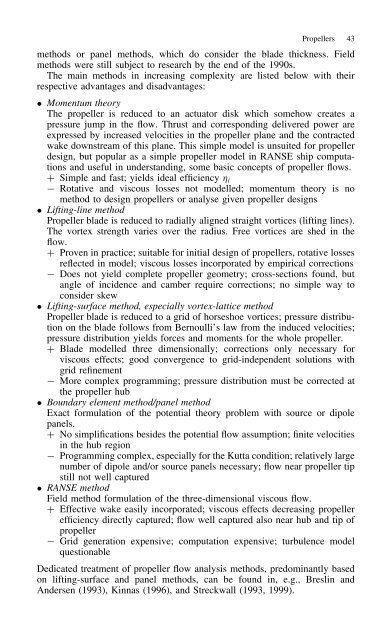Practical Ship Hydrodynamics
Practical Ship Hydrodynamics
Practical Ship Hydrodynamics
You also want an ePaper? Increase the reach of your titles
YUMPU automatically turns print PDFs into web optimized ePapers that Google loves.
Propellers 43<br />
methods or panel methods, which do consider the blade thickness. Field<br />
methods were still subject to research by the end of the 1990s.<br />
The main methods in increasing complexity are listed below with their<br />
respective advantages and disadvantages:<br />
ž Momentum theory<br />
The propeller is reduced to an actuator disk which somehow creates a<br />
pressure jump in the flow. Thrust and corresponding delivered power are<br />
expressed by increased velocities in the propeller plane and the contracted<br />
wake downstream of this plane. This simple model is unsuited for propeller<br />
design, but popular as a simple propeller model in RANSE ship computations<br />
and useful in understanding, some basic concepts of propeller flows.<br />
C Simple and fast; yields ideal efficiency i<br />
Rotative and viscous losses not modelled; momentum theory is no<br />
method to design propellers or analyse given propeller designs<br />
ž Lifting-line method<br />
Propeller blade is reduced to radially aligned straight vortices (lifting lines).<br />
The vortex strength varies over the radius. Free vortices are shed in the<br />
flow.<br />
C Proven in practice; suitable for initial design of propellers, rotative losses<br />
reflected in model; viscous losses incorporated by empirical corrections<br />
Does not yield complete propeller geometry; cross-sections found, but<br />
angle of incidence and camber require corrections; no simple way to<br />
consider skew<br />
ž Lifting-surface method, especially vortex-lattice method<br />
Propeller blade is reduced to a grid of horseshoe vortices; pressure distribution<br />
on the blade follows from Bernoulli’s law from the induced velocities;<br />
pressure distribution yields forces and moments for the whole propeller.<br />
C Blade modelled three dimensionally; corrections only necessary for<br />
viscous effects; good convergence to grid-independent solutions with<br />
grid refinement<br />
More complex programming; pressure distribution must be corrected at<br />
the propeller hub<br />
ž Boundary element method/panel method<br />
Exact formulation of the potential theory problem with source or dipole<br />
panels.<br />
C No simplifications besides the potential flow assumption; finite velocities<br />
in the hub region<br />
Programming complex, especially for the Kutta condition; relatively large<br />
number of dipole and/or source panels necessary; flow near propeller tip<br />
still not well captured<br />
ž RANSE method<br />
Field method formulation of the three-dimensional viscous flow.<br />
C Effective wake easily incorporated; viscous effects decreasing propeller<br />
efficiency directly captured; flow well captured also near hub and tip of<br />
propeller<br />
Grid generation expensive; computation expensive; turbulence model<br />
questionable<br />
Dedicated treatment of propeller flow analysis methods, predominantly based<br />
on lifting-surface and panel methods, can be found in, e.g., Breslin and<br />
Andersen (1993), Kinnas (1996), and Streckwall (1993, 1999).
















